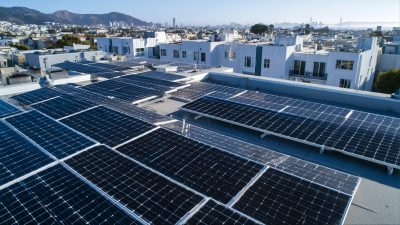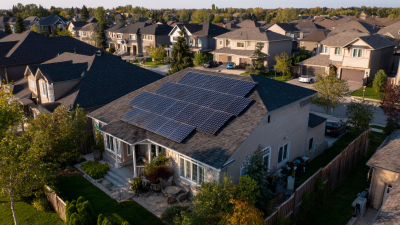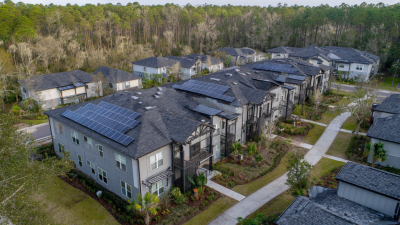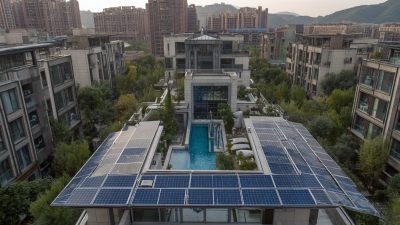As the demand for clean energy continues to rise, maximizing efficiency in residential solar systems has become a focal point for homeowners and industry professionals alike. According to the Solar Energy Industries Association (SEIA), residential solar installations in the United States grew by over 20% in 2022, demonstrating the escalating interest in solar energy solutions. However, to truly harness the potential of these systems, homeowners must focus on efficiency enhancements that can significantly impact their return on investment. A recent report by the National Renewable Energy Laboratory (NREL) highlights that optimizing system performance can increase energy output by up to 30%, underscoring the importance of data-driven insights in decision-making. This blog will explore various methods and practices designed to maximize the efficiency of residential solar systems, ensuring that homeowners not only adopt solar energy but also benefit from its full capabilities.

Understanding the components of residential solar systems is crucial for optimizing their efficiency. A typical solar energy setup includes solar panels, inverters, battery storage, and a monitoring system, each playing a vital role in enhancing energy production and usage. According to the U.S. Department of Energy, the efficiency of solar panels has improved significantly over the years, with top models now exceeding 22% efficiency, allowing homeowners to generate more electricity from the same amount of sunlight. Additionally, investing in high-quality inverters can increase system efficiency by ensuring that the energy harvested from the panels is converted to usable electricity with minimal losses.
Battery storage is another critical component that can greatly influence the overall efficiency of residential solar systems. A report from the National Renewable Energy Laboratory (NREL) highlights that integrating battery storage can enable homeowners to utilize their solar energy even when the sun is not shining, effectively reducing reliance on grid power and enhancing energy independence. Furthermore, real-time monitoring systems can provide valuable insights into energy production and consumption patterns, allowing users to make data-driven decisions to optimize performance. Regular maintenance and timely upgrades to these components not only enhance efficiency but also extend the life of the entire solar system.
To maximize the efficiency of residential solar systems, it’s crucial to monitor key data metrics that can significantly influence performance. Firstly, tracking solar production through real-time monitoring systems allows homeowners to understand how much energy their panels are generating throughout the day. Metrics such as peak production times and total energy output help in identifying patterns and making informed decisions about energy usage. By analyzing this data, homeowners can adjust their consumption habits to align with periods of peak sunlight, ultimately leading to increased self-consumption and reduced reliance on grid power.
Additionally, monitoring weather conditions and environmental factors is essential for optimizing solar performance. Data on temperature, humidity, and shading can impact the efficiency of solar panels. For example, higher temperatures can reduce efficiency, while excessive shading can drastically lower output. By integrating weather data analysis with solar production metrics, homeowners can anticipate changes and take proactive measures, such as optimizing panel placement or adjusting usage patterns during inclement weather. By focusing on these key data metrics, homeowners can enhance their solar energy systems' efficiency, ensuring they get the most out of their investment.
This chart illustrates the average monthly energy production (in kWh) compared to the average monthly sunlight hours for residential solar systems. By monitoring these key metrics, homeowners can identify optimal performance levels and areas for improvement.
Innovative technologies are at the forefront of enhancing the efficiency of residential solar systems, paving the way for a robust transition to renewable energy. Recent advancements in photovoltaic (PV) technology demonstrate significant progress in maximizing energy output while minimizing environmental impact. For instance, the introduction of advanced solar dish concentrators utilizing vacuum hemispherical cavity receivers showcases how innovative design can improve thermal energy capture. By focusing on energy and exergy evaluations, these systems are proving to be more efficient and effective, ultimately supporting the urgent need for climate change mitigation.

Additionally, the development of energy-efficient retrofitting solutions, such as the novel solar exoskeleton, represents a transformative approach for existing buildings. This prototype addresses the dual challenge of enhancing energy performance and architectural aesthetics. By integrating solar energy systems seamlessly into building designs, these innovations not only reduce greenhouse gas emissions but also contribute to achieving NetPlus targets for energy efficiency. As the renewable energy landscape continues to evolve, such pioneering technologies offer promising pathways for homeowners looking to maximize their solar investment and embrace a sustainable lifestyle.
Maintaining solar panels is crucial for ensuring optimal performance and maximizing efficiency in residential solar systems. Research indicates that regular cleaning and maintenance can enhance energy output by up to 20%. Dirty panels accumulate dust, debris, and other pollutants, which significantly reduce their ability to capture sunlight effectively. As such, home owners should adopt a routine cleaning schedule to prevent soiling, ideally every 6 months, or more frequently in dusty environments.
For those considering DIY cleaning methods, it's essential to use the right tools and techniques to avoid damaging the panels. Soft brushes, squeegees, and mild detergents can be effective, but care must be taken to ensure that the cleaning is done safely and without harm to the solar installations. Professional services offer more robust cleaning solutions, usually employing advanced tools and safety precautions—yet, these services come with their own costs. Moreover, emerging cleaning technologies, such as waterless cleaning methods, are being developed to cater to water-scarce regions, showcasing innovation in the field of solar asset management that prioritizes both efficiency and environmental considerations. These practices and technologies underline the importance of a well-rounded maintenance approach to achieve long-term performance in solar photovoltaic systems.
Maximizing efficiency in residential solar systems through data-driven insights can significantly enhance energy management strategies. By leveraging data analysis, homeowners can optimize their energy consumption patterns, leading to more effective use of solar energy. Integrating smart technologies, such as IoT devices, allows for real-time monitoring and management of energy usage, helping users identify peak consumption times and adjust their power usage accordingly.

Tips for improving energy management include regularly reviewing energy consumption reports generated by smart meters. Homeowners should analyze these reports to pinpoint inefficiencies and discover how to shift energy-heavy tasks to times when solar production is at its highest. Additionally, combining solar technology with artificial intelligence can lead to improved predictive maintenance strategies, ensuring that systems operate at peak efficiency and reducing downtime.
Another helpful approach is utilizing automated energy management systems to dynamically adjust settings based on changing weather conditions, which can enhance solar output and overall home energy management.






As electricity costs continue rising, many small households in Maharashtra seek sustainabl...Read More
Uttar Pradesh is making significant progress in adopting renewable energy, particularly so...Read More
With the Indian government actively promoting renewable energy through subsidies and polic...Read More
Tired of watching your electricity bills climb month after month and strain your pockets? ...Read More
Switching to solar energy in Gujarat has never been more profitable! With plenty of sunlig...Read More
If you live in Madhya Pradesh and want to save money on power while living a greener lifes...Read More
If you’re a resident of Bangalore looking to save on your skyrocketing electricity b...Read More
If you live in Karnataka and have been looking for an environmentally friendly, cost-effec...Read More
Delhi is a city that thrives on its vibrant energy, and what better way to complement that...Read More
As electricity costs continue rising, many small households in Maharashtra seek ...Read More
Uttar Pradesh is making significant progress in adopting renewable energy, parti...Read More
With the Indian government actively promoting renewable energy through subsidies...Read More